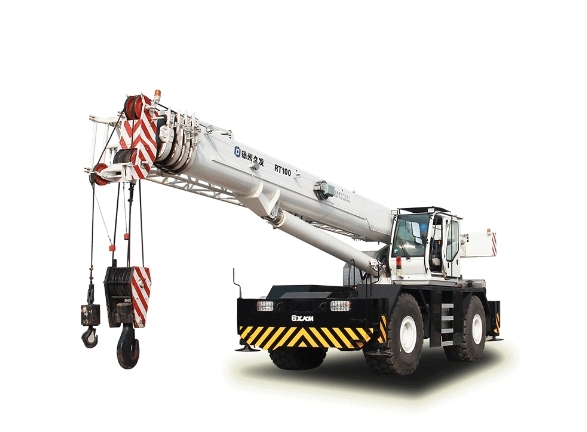At construction sites, the 100 ton rough terrain crane is a formidable machine. One of the leading manufacturers in this industry is XJCM. This powerful piece of equipment combines impressive lifting capacity with exceptional mobility, making it an indispensable asset in a wide range of construction projects. In this blog, we’ll delve into the features and capabilities of the XJCM 100 ton rough terrain crane.
The XJCM 100 ton rough terrain crane is a symbol of power, precision, and reliability. It’s impressive specifications, when combined with proper maintenance and safe operating practices, make it an invaluable asset on construction sites: capable of handling the most challenging lifting tasks. Construction professionals can trust in XJCM’s commitment to excellence and rely on this crane to get the job done efficiently and safely – ensuring successful projects and the continued growth of the construction industry.
XJCM High-Quality 100 Ton Rough Terrain Crane: What You Should Know
1.Lifting Capacity
As the name suggests, the XJCM 100 ton rough terrain crane boasts an impressive lifting capacity, capable of hoisting loads weighing up to 100 tons or a whopping 200,000 pounds. This remarkable strength makes it suitable for tackling even the heaviest of construction tasks with ease.
2. All-Terrain Mobility
One of the standout features of this crane is its ability to traverse a variety of challenging terrains. Whether it’s uneven, rough, or unpaved surfaces, the XJCM 100 ton rough terrain crane excels. Thanks to its large, rugged tires and robust four-wheel-drive or all-wheel-drive systems, it can maneuver through difficult conditions with confidence and stability.

3. Telescopic Boom
The crane’s telescopic boom is a crucial component that allows it to reach impressive heights. This boom can extend to varying lengths, typically ranging from 30 to 150 feet or even more. The telescopic design enables the crane to adapt to the specific needs of each job, reaching the required height while maintaining stability.
4. Counterweights
Safety is paramount in heavy lifting, and the XJCM 100 ton rough terrain crane prioritizes stability through its adjustable counterweights. These counterweights can be fine-tuned to balance the load and prevent the crane from tipping during lifting operations.
5. Operator Cab
The crane’s operator is in full control from a well-equipped cab situated on the crane itself. This climate-controlled cabin features modern controls, safety features, and visibility aids, ensuring the operator can work comfortably and efficiently even in adverse weather conditions.
6. Hydraulic Systems
The crane’s hydraulic systems are the heart of its operation. They enable precise control over the boom’s movements, including lifting and lowering loads, extending and retracting the boom, and swinging the load into position. This hydraulic power ensures smooth and reliable performance.
7. Outriggers
To enhance stability, especially on uneven ground, stabilizing outriggers are deployed when the crane is in use. These extend from the sides of the crane’s chassis, providing an additional layer of support to ensure safe and secure lifting.
8.Transportability
Despite its substantial size and lifting capacity, the XJCM 100 ton rough terrain crane is designed for transportability. With the necessary permits, it can be driven on highways to and from job sites. Some models even offer the convenience of disassembly for easier transportation, further enhancing its versatility.
9. Safety Features
Safety is a top priority in crane operation, and this crane is equipped with a range of safety features to protect both operators and the work site. Load moment indicators (LMI) prevent overloading, emergency stop mechanisms provide immediate shutdown in case of issues, and alarms ensure safe operations at all times.
10. Applications
The XJCM 100 ton rough terrain crane finds its place in various construction applications. It excels at erecting steel structures, lifting heavy equipment, placing concrete elements, and handling materials in industrial settings, making it an indispensable tool in the construction industry.
XJCM High-Quality 100 Ton Rough Terrain Crane: Maintenance Best Practices
A well-maintained crane is essential for safe and efficient operations. Here are some maintenance best practices to keep the XJCM 100 ton rough terrain crane in top condition:
1. Regular Inspections: Conduct routine inspections to identify any signs of wear and tear, loose components, or potential issues. Address these promptly to prevent costly breakdowns.
2. Lubrication: Properly lubricate all moving parts to reduce friction and extend the crane’s lifespan. Follow manufacturer-recommended lubrication schedules.
3. Training: Ensure that operators and maintenance personnel are trained in crane operation and maintenance procedures to minimize the risk of accidents and equipment damage.
4. Documentation: Maintain detailed records of all maintenance and repair activities. This documentation helps in tracking the crane’s history and aids in making informed decisions.
Best Practices for Operating the XJCM 100 Ton Rough Terrain Crane
Efficient operation of this powerful crane requires skill and adherence to safety protocols:
1. Load Calculation: Precisely calculate the load weight and ensure it does not exceed the crane’s capacity. Overloading can lead to catastrophic accidents.
2. Stability: Always set up the crane on stable ground and use outriggers or stabilizers to maintain balance during lifting operations.
3. Communication: Establish clear communication channels between the crane operator and ground personnel to coordinate movements and ensure safety.
4. Weather Conditions: Be mindful of weather conditions, especially wind speeds, which can affect the crane’s stability and operation.
Conclusion
The XJCM 100 ton rough terrain crane stands as a testament to engineering excellence in heavy lifting machinery. With its impressive lifting capacity, all-terrain mobility, and an array of safety features, it plays a pivotal role in the success of construction projects, making it a valuable asset for construction companies worldwide.



